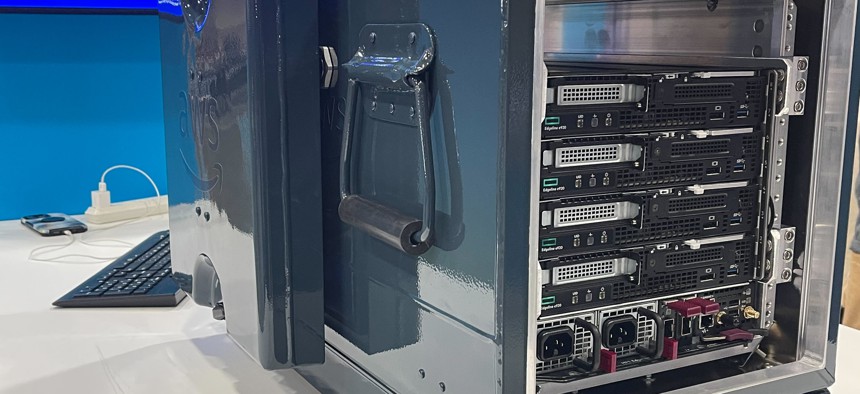AWS unveils edge device for Defense customers in most extreme environments

The AWS Snowblade edge computing device on display at the June 7, 2023 AWS Summit in Washington, D.C. Frank Konkel/Staff
The 80-pound AWS ‘Snowblade’ device provides cloud services to end users at all classification levels while meeting the military’s highest ruggedization standards.
Amazon Web Services launched its most extreme edge computing product yet Wednesday — called AWS Snowblade — available specifically for Department of Defense and military customers through the recently-awarded Joint Warfighting Cloud Capability Contract.
The portable hardware device is only about the size of a mini-fridge but is designed to provide compute, storage and other cloud and hybrid computing services to defense customers operating in the most remote, extreme environments on the planet, including denied, disrupted, intermittent and limited — or DDIL — environments.
Encased in protective shielding, the device weighs about 80 pounds — it has two handles on each side for carrying by one or two people — and meets U.S. Military Ruggedization Standards (MIL-STD-810H), which allows customers to operate it even when subjected to shock, vibration and temperatures up to more than 130 degrees.
AWS Snowblade “enables our DOD customers to run their operations and manage demanding workloads in edge locations all around the world subject to extreme operating environments,” Max Peterson, vice president of worldwide public sector at AWS, said Wednesday at the company’s Washington, D.C. Summit.
AWS Snowblade is compatible with other AWS ‘Snow’ family products popular among defense and intelligence agencies and supports an assortment of cloud services widely in use among public sector customers.
Importantly, the devices are shipped to customers fully provisioned “to make them as easy to use as possible” for field operators, according to Ramesh Kumar, head of product and solutions for AWS Snow Family.
Kumar added that data on the AWS Snowblade edge devices are secured with 256-bit encryption and 2-layer encryption at transport, and the product meets FedRAMP-High as well as IL5 and IL6 certification for classified data. Encryption keys aren’t stored on the device itself, either. In short, Kumar said that, should the device fall into enemy hands, it’s basically an “80-pound block.”
For years, Defense officials have sought these kinds of edge computing capabilities that allow warfighters and other Defense customers to continue operations in remote, austere environments with intermittent internet connectivity. The Pentagon’s Joint All-Domain Command and Control Strategy, or JADC2, outlines the need to “enable rapid relevant decision-making from the strategic level to the tactical edge.”
JADC2 is “utterly reliant on having an enterprise cloud capability that operates at all three security classifications — top secret, secret, unclassified — from the continental United States all the way up to the tactical edge,” Defense Department Chief Information Officer John Sherman said in November, noting JWCC was the “the fundamental pillar of JADC2.”



